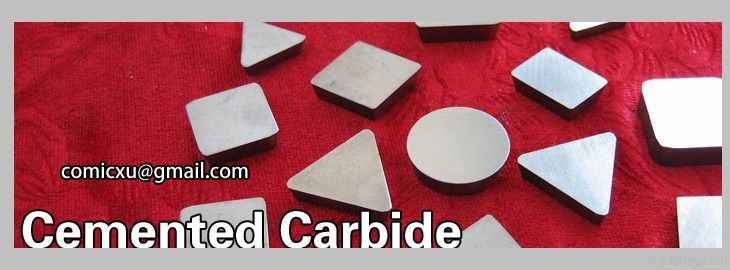La description
Cemented carbide
Cemented carbide, also called tungsten carbide,
hardmetal,or widia, is a hard material used in
machining tough materials such as carbon steel or stainless
steel, as well as in situations where other tools would wear
away, such as high-quantity production runs. Most of the time,
carbide will leave a better finish on the part, and allow faster
machining. Carbide tools can also withstand higher temperatures
than standard high speed steel tools.
Composition
Cemented carbide is a metal matrix composite where tungsten carbide
particles are the aggregate and metallic cobalt serves as the
matrix. The process of combining tungsten carbide with cobalt is
referred to as sintering or Hot Isostatic Pressing (HIP). During
this process cobalt eventually will be entering the liquid stage
and WC grains (much higher melting point) remain in the solid
stage. As a result of this process cobalt is embedding/cementing
the WC grains and thereby creates the metal matrix composite with
its distinct material properties. The naturally ductile cobalt
metal serves to offset the characteristic brittle behavior of the
tungsten carbide ceramic, thus raising its toughness and
durability. Such parameters of tungsten carbide can be changed
significantly within the carbide manufacturers sphere of influence,
primarily determined by grain size, cobalt content, dotation (e.g.
alloy carbides) and carbon content.Applications
Inserts for metal cutting Tungsten-carbide tools
Carbide is more expensive per
unit than other typical tool materials, and it is more
brittle, making it susceptible to chipping and breaking. To offset
these problems, the carbide cutting tip itself is often in the form
of a small insert for a larger tipped tool whose shank is made of another
material, usually carbon tool
steel. This gives the benefit of using carbide at the
cutting interface without the high cost and brittleness of making
the entire tool out of carbide. Most modern face mills use carbide
inserts, as well as many lathe tools and endmills. In recent decades, though,
solid-carbide endmills have also become more commonly used,
wherever the application's characteristics make the pros (such as
shorter cycle times) outweigh the cons (mentioned above). Coatings:
To increase the life of carbide tools, they are sometimes coated.
Four such coatings are TiN (titanium
nitride), TiC (titanium
carbide), Ti(C)N (titanium
carbide-nitride), and TiAlN (titanium aluminum nitride). (Newer
coatings, known as DLC (Diamond-like
carbon) are beginning to surface, enabling the cutting power
of diamond without the unwanted chemical reaction between real
diamond and iron.) Most coatings generally increase a tool's
hardness and/or lubricity. A coating allows the cutting edge of a
tool to cleanly pass through the material without having the
material gall (stick) to it.
The coating also helps to decrease the temperature associated with
the cutting process and increase the life of the tool. The coating
is usually deposited via thermal CVD and, for certain applications, with the
mechanical PVD method. However
if the deposition is performed at too high temperature, an eta
phase of a Co6W6C tertiary carbide forms at the
interface between the carbide and the cobalt phase, facilitating
adhesion failure of the coating.
Inserts for mining tools
Mining and tunneling cutting tools are most often fitted with
Cemented Carbide tips the so called "Button Bits". Only man made
diamond may replace the Cemented Carbide s when conditions
are ideal, but as rock drilling is a tough job the Cemented
Carbide bits remain the most used type throughout the
world.
Rolls for Hot and Cold roll applications
Steel mills round the world have since mid****0s applied Cemented
carbide hot and cold rolls for shaping of tubes, bars and flats.
Other industrial applications
This category contain a countless number of applications, but can
though be split into three main areas:
- Engineered Components
- Wear Parts
- Tools & Toolblanks
Some key areas where Cememted Carbide components are used:
Automotive Components, Canning Tools for deep-drawing of
two-piece cans, Rotary Cutters for high speed cutting of man made
fibres, Metal Forming Tools for wire drawing and stamping
applications, Rings & Bushings typically for bump and seal
applications, Wood working i.e. for sawing and plane
applications, Pump pistons for high performance pumps in e.g.
nuclear installations, Nozzles e.g. high performance nozzles for
oil drilling applications, Roof and tail tools & components
for high wear resistance, Balls for ball bearings and ball pens.
| Pays: |
China |
| N ° de modèle: |
SPT1601
|
| Prix FOB: |
(Negotiable)
Obtenir le dernier prix
|
| Localité: |
- |
| Prix de commande minimale: |
- |
| Commande minimale: |
- |
| Packaging Detail: |
bulk packing |
| Heure de livraison: |
30 days |
| Capacité de Fournir: |
- |
| Payment Type: |
L/C, T/T |
| Groupe de produits : |
- |

